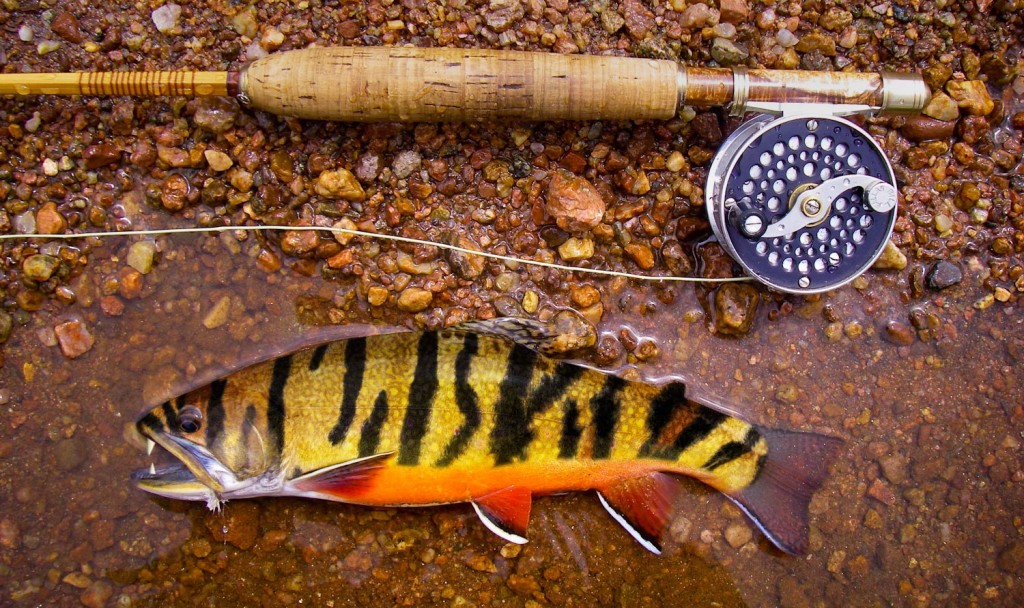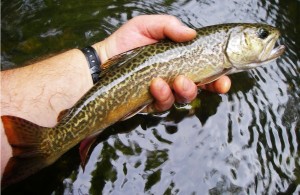Wild tiger trout may be the rarest of the trout family.
They are a hybrid of a female brown trout and a male brook trout. They are distinctive, the dark modeled pattern of a brook trout’s back extending down their sides to their belly. This bold pattern won them the name tiger trout. The pattern more closely resembles the coat of an ocelot but I suppose ocelot trout sounds silly.
Browns and brooks are both fall spawners so it’s bound to happen that some big beautiful brown trout catches the eye of an eager brookie but getting a tiger out of the deal is still tricky. A brook trout, being a char, has 84 chromosomes and a brown trout only 80. A fertilized egg will yield a fry only 5% of the time. The resulting tiger trout is sterile so there is no tiger trout to tiger trout reproduction.
The science guys have figured out how to make tiger trout in the lab. They fertilize the brown trout eggs with brook trout milt and then shock them with heat which causes the eggs to mutate adding a chromosome pair and boosting the success rate to 85%. A pretty cool trick but why would you do it?
Well, it turns out that the tiger isn’t just in the stripes. Tiger trout have the attitude to boot. They are aggressive piscivores and grow quickly, eating every smaller fish they can. For that reason they have proven to be an effective tool for controlling invasive species. Since they are sterile, there is no fear of their population getting out of hand.
I’m not a big fan of tinkering with the ecosystem and used carelessly, tiger trout could reek havoc on native fish. However several states have used tiger trout stocking as a means of controlling unwanted species and the result is often great fishing. Tiger trout are aggressive and with the record being twenty pounds, a tempting target species.
I’ve never caught a wild tiger trout but my buddy Dan Flynn shared this photo with me. He’s caught two. I guess if I were serious about it I’d target streams where brook and brown trout spawn together and fish small streamers in hopes of finding one but I don’t. Maybe it will happen one day, or maybe not. If it does you’ll hear about it. For now, it’s cool knowing there’s something out there that I haven’t found yet.
Come fish with us in the Bahamas!
Louis Cahill Gink & Gasoline www.ginkandgasoline.com hookups@ginkandgasoline.com Sign Up For Our Weekly Newsletter!


I’ve never heard of a tiger trout. Just one more excuse to keep fishing!
Amen!
One of the coolest fish out there and there are places where you can find them naturally.
A few here in GA but they are like hens teeth.
Fish the Driftless!
Now you’re talking! If you have photos post them on the G&G Facebook page.
Are those teeth for real? They remind me of a ‘cuda or a tiger fish from Africa…
I was waiting for someone to ask. Thanks for stepping up. NO! That is a brook trout that I added tiger print and fangs to in photoshop. My idea of a joke. The inset photo is a real tiger trout and a natural wild one at that.
I’ll post some Tigers to your wall! They come from Nacho Business Creek, WY. hahaha
Those are some beautiful tigers Man! Thanks for sharing.
So stunned by that lab tiger…had to take a second look and notice that gorgeous rod.
Thanks! That’s one of my favorites. A Granger 7030 taper. 7′ 4wt hollow built. Aluminum bronze hardware except for the stripper and tip top which are 24K gold plated nickel silver. Curly Kona burl for the reel seat. I made it for a trip to Yellowstone. Get it? A yellow rod for Yellowstone.
Very clever, indeed!
Pingback: Finding Steelhead Tiger Trout Fishing | MidCurrent | MidCurrent
Have not caught one yet. But hoping to
We’re pulling for you man. Target streams with both wild brown and brook trout and fish streamers. That’s your best bet.
Love the “lab tiger” at the header. LOL If anyone’s ever in Utah, we’ve got one of the best tiger programs around. They’re stocked like rainbows out here, these days.
I’ve made quite a few blog posts with decent tigers in them.
Oh, I need to try that.
Ho Ho very funny , God bless photoshop. You could jab done a better job with the teeth though guys.
I used to caretake a recreational property just outside Bozeman owned by a Chicago photographer and fly fisher. The Gallatin river formed the western property line and we had a spring creek fed pond that was home to lots of big browns and a lesser number of small to medium brookies. Over 30 years of fishing that pond I’ve caught two or three wild, naturally occurring tiger trout. So yeah, they’re kind of rare, even in an environment where brookies and browns spawn in close proximity to one another. My wife and I remained close to the owners over the years and we now have a growing relationship with the new owners. I’ll fish the river this weekend and the pond once the ice is off. I’m a lucky guy.
I have only caught one and mistakenly took it for a brown with a funky spot pattern. I showed the photo to a conservation officer friend who corrected me. Thanks for the article.Tiger trout don’t get much love in the fly fishing media world.
What does the opposite paring, a male brook trout and a female brown trout produce? Is it possible?
Are similar crosses between other salvelinus possible? I’m wondering what a cross between a brown trout and a bull trout, Salvelinus confluentus, a highly piscatorial species would produce.
We have some planted in a couple lakes in the Cascades here in Oregon to wipe out the invasive monsters.
Louis next time you come up here to hit the Deschutes try a day trip over to Diamond Lake where ODFW have planted Tigers. It’s about 90 minutes from Bend. It’s right next to Crater Lake National Park.
Plus we have the Williamson and the Wood and the Rogue and the Umpqua and the… Yup we are spoiled.
I’ve caught a bunch of tigers in Utah waters with the largest being 17″. And believe me, I’m not bragging. From my small sample size experience, “aggressive” unfortunately means “dumb” or “easy” when it comes to catching them. The tigers sit out in the middle, while the other trout hang against the bank. Like so many stocked fish they aren’t picky and will push aside the native or holdover trout to get to your fly. As a bonus, they don’t put up much of a fight. All the creeks where I’ve found tigers (6-7?) were fine before they got there. I’m not sure if they were inserted to lessen some invasive minnow or “trash” fish but they sure knock down the fishing for browns, bows and cutts. It’s hard not to think they came from a state fisheries official thinking “Hey, let’s really up the catch rate on xxxx Creek.” Yes, the result of mixing the coloration and markings of a brown and a brookie is pretty, even incredible on a large “spawner”. For me that’s been the only consolation. Sorry to be so negative about something that sounds exciting. Again, this only my experience on a small number of small Utah creeks. Thanks for posting this article.
That image on top is fake. Take it down
That image is a joke dude. If you can’t fish with a sense of humor, don’t fish.
Hello everybody!
No, tiger trout are not good at all:
– they are competing with native species, especially as they are more aggressive they are more noxious;
– studies found that the interbreeding of brook char with native brownies (in Pyrenees mountains, France) leads slowly but surely to a severe reduction of trout populations; there is then a possibility that native char are then threaten the same by brown trout in America…
– the native fish that are mating with the introduced ones are reducing the reproduction success of the native.
– they are not all sterile, a few of them are fertile and leading to increased native population solution.
And some other inconvenient that cannot all be listed here.
Nature is not our toy: it is a garden of which we shall care. Those chimeras have nothing to do in the wilderness… Keep them in ponds for training newbies and that’s it.
It’s important to remember the difference between the fish and the fisheries management. Tiger trout occur naturally most places. In the states where they are raised and stocked, yes, it’s a problem but most states do not raise and stock them. Poorly managed stocking is always a problem. A wild fish never is.